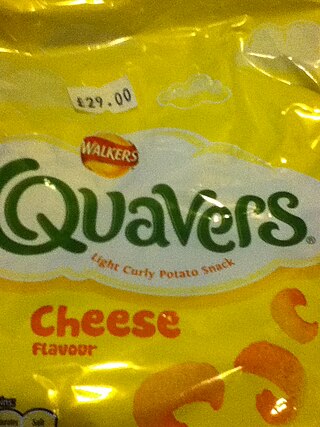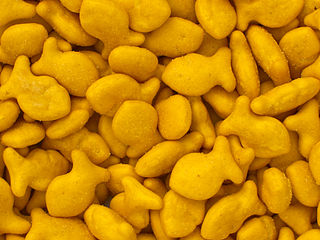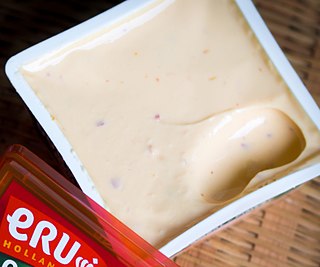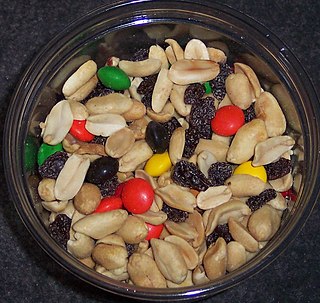
Finnish cuisine is notable for generally combining traditional country fare and haute cuisine with contemporary continental-style cooking. Fish and meat play a prominent role in traditional Finnish dishes in some parts of the country, while the dishes elsewhere have traditionally included various vegetables and mushrooms. Evacuees from Karelia contributed to foods in other parts of Finland in the aftermath of the Continuation War.

String cheese is any of several different types of cheese where the manufacturing process aligns the proteins in the cheese, which makes it stringy.

KD in Canada, Kraft Mac & Cheese in the United States, Australia and New Zealand, Mac and Cheese in the United Kingdom and internationally, is a nonperishable, packaged macaroni and cheese product. It is made by Kraft Foods Group and traditionally cardboard-boxed with dried macaroni pasta and a packet of processed cheese powder. It was introduced under the Kraft Dinner name simultaneously in both Canada and the U.S. in 1937. The brand is particularly popular with Canadians, who consume 55% more boxes per capita than Americans.

Convenience food is food that is commercially prepared for ease of consumption, and is usually ready to eat without further preparation. It may also be easily portable, have a long shelf life, or offer a combination of such convenient traits. Convenience foods include ready-to-eat dry products, frozen food such as TV dinners, shelf-stable food, prepared mixes such as cake mix, and snack food. Food scientists now consider most of these products to be ultra-processed foods and link them to poor health outcomes.

Processed cheese is a product made from cheese mixed with an emulsifying agent. Additional ingredients, such as vegetable oils, unfermented dairy ingredients, salt, food coloring, or sugar may be included. As a result, many flavors, colors, and textures of processed cheese exist. Processed cheese typically contains around 50 to 60% cheese and 40 to 50% other ingredients.

Planters Nut & Chocolate Company is an American snack food company now owned by Hormel Foods. Planters is best known for its processed nuts and for the Mr. Peanut icon that symbolizes them. Mr. Peanut was created by grade schooler Antonio Gentile for a 1916 contest to design the company's brand icon. The design was modified by a commercial artist and has continued to change over the years.

Cheez Whiz is a brand of processed cheese sauce or spread produced by Kraft Foods. It was developed by a team led by food scientist Edwin Traisman (1915–2007). It was first sold in 1952, and with some changes in formulation continues to be in production today.

Quavers are a deep-fried potato-based British snack food. Launched in the UK in 1968, they were originally made by Smith's in their factory on Newark Road in the Bracebridge area of Lincoln. Since 1997 they have been produced by Walkers. The name comes from the musical note, quaver.

Capri-Sun is a brand of juice concentrate–based drinks manufactured by the German company Wild and regional licensees. Rudolf Wild invented the drink in 1969 and introduced it in West Germany as Capri-Sonne. It is now sold in over 100 countries, with licensees including Kraft Foods in the United States and Coca-Cola Europacific Partners in parts of Europe. It is one of the most popular juice brands in the world; as of 2023, roughly 6 billion pouches are sold per year globally.

Goldfish is a brand of fish-shaped cracker with a small imprint of an eye and a smile manufactured by Pepperidge Farm, which is a division of the Campbell Soup Company. The brand's current marketing and product packaging incorporate this feature of the product: "The Snack That Smiles Back! Goldfish!", reinforced by Finn, the smiling goldfish mascot with sunglasses. The product is marketed as a "baked snack cracker" on the label with various flavors and varieties.

Wheat Thins is a brand of baked whole grain snack food crackers distributed in the United States and Canada by Mondelez International. The product is also available in Australia through wholesaler USA Foods. Vegetable Thins, Oat Thins, Pita Thins, and Rice Thins, which are all spinoffs of Wheat Thins, are available in Canada and some regions of the United States. Wheat Thins themselves come in many flavors and varieties. Nabisco first introduced the product in 1947.

Cheese spread is a soft spreadable cheese or processed cheese product. Various additional ingredients are sometimes used, such as multiple cheeses, fruits, vegetables and meats, and many types of cheese spreads exist. Pasteurized process cheese spread is a type of cheese spread prepared using pasteurized processed cheese and other ingredients.

Kraft Foods Inc. was a multinational confectionery, food and beverage conglomerate. It marketed many brands in more than 170 countries. Twelve of its brands annually earned more than $1 billion worldwide: Cadbury, Jacobs, Kraft, LU, Maxwell House, Milka, Nabisco, Oreo, Oscar Mayer, Philadelphia, Trident, and Tang. Forty of its brands were at least a century old.
Dairylea is a popular brand of processed cheese products produced by Mondelēz International and available in Ireland and the United Kingdom. As of 2017, it is also available in Australia.

Velveeta Shells & Cheese is a shell pasta and cheese sauce food product that debuted in the United States in 1984, as part of the Velveeta brand products. Its ingredients, texture, and flavor are very similar to macaroni and cheese. The product is a shelf-stable food.

A snack is a small portion of food generally eaten between meals. A snack is often less than 200 calories, but this can vary. Snacks come in a variety of forms including packaged snack foods and other processed foods, as well as items made from fresh ingredients at home.

Cheese and crackers, also known as cheese and biscuits in the UK, is a dish consisting of crackers paired with cheese. Historically the fare of sailors, soldiers, and pioneers, it had become a regular menu item in American restaurants and bars by the 1850s. Many types of cheeses are used, and it is often paired with wine. It may also be served with fruit preparations or preserves, or preserved meats, such as pepperoni or salami. Mass-produced cheese and crackers include Handi-Snacks, Ritz, Jatz and Lunchables.

Salt Sugar Fat: How the Food Giants Hooked Us is a book by Michael Moss published by Random House in 2013 that won the James Beard Foundation Award for Writing and Literature in 2014. It also was a number one New York Times bestseller in 2013. In his book, Moss cites examples from Kraft, Coca-Cola, Lunchables, Frito-Lay, Nestlé, Oreos, Capri Sun, and many more, where scientists calculate the combination of sugar, fat and salt for convenience food that is guaranteed to have an optimal appeal for the customer. The "conditioned hypereating" discussed in this book was also mentioned in a 2009 book by former FDA director David A. Kessler.

















